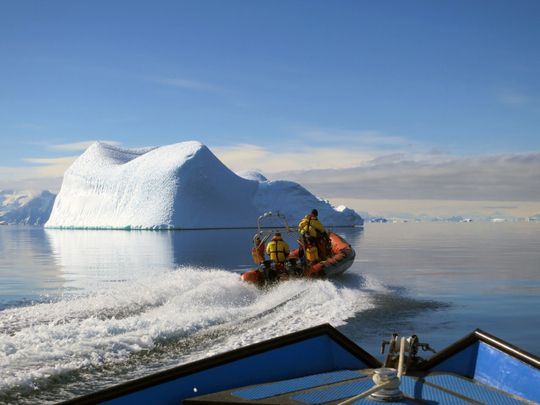
Climate change will dramatically alter life in the oceans, scientists say, but there is so much still to learn about marine ecosystems that it is hard to know exactly how.
Last week, researchers with the British Antarctic Survey offered a glimpse of that future with the results of an unusual study years in the making. The scientists heated a patch of the sea floor off the coast of Antarctica and tracked the effects on a few local species. Some animals responded by doubling their growth, stunning the researchers. At the same time, there was evidence that animals that thrive on warmth might crowd out less resilient species. The study was published in the journal Current Biology.
The cold, dry ecosystems on Antarctica itself cannot support anything bigger than an insect. But the Antarctic Ocean swirling around the continent paradoxically teems with life.
A rich supply of nutrients fosters a food web that includes single-celled algae and bottom-dwelling worms. This ecosystem ultimately supports predators such as fish, penguins and whales.
Climate change is a big concern here, because heat-trapping gases such as carbon dioxide are having their biggest effects near the poles. Computer models predict that in 50 years the Antarctic Ocean will warm by about 1.8 degrees Fahrenheit, and by 3.6 degrees Fahrenheit within a century.
“We’re going to start to see changes there first,” said Gail V. Ashton, an author of the study and a marine ecologist now at the Smithsonian Environmental Research Center in Tiburon, California.
Trying to predict those changes, scientists have been gathering various sorts of clues. Some look at the natural ranges of Antarctic species, observing the highest temperatures they tolerate. Others put animals into laboratory tanks and manipulate the aquatic environment.
But these experiments have shortcomings of their own. “Control is also a weakness,” said Rebecca L. Kordas, a marine ecologist at Imperial College London who was not involved in the new study. “Too much control may yield unnatural responses.”
In recent years, scientists like Kordas have attempted another kind of experiment: heating the ocean itself. The research typically involves putting heated panels underwater, close to shore, and then observing how the temperature increases affect the growth of tiny animals on the seafloor.
Scientists previously used this method off the coasts of British Columbia and Australia. In the new study, British Antarctic Survey researchers picked a tougher site: about 45 feet deep in the Antarctic Ocean, off the Antarctic Peninsula coast. The study sheds new light on Antarctic ecosystems, said Julian Gutt of the Helmholtz Center for Polar and Marine Research in Germany: “To my knowledge, it is unique.”
Ashton travelled to Rothera Research Station on Adelaide Island to begin the experiment. She and her colleagues sailed offshore and then dove underwater to set the panels on concrete footings on the ocean floor.
To power the panels, the scientists ran 600 feet of cable to a station generator on shore. The experiment began in January 2014, but before long the cables were severed. “We’re not sure if it was an iceberg or a ship that dinged them,” Ashton said.
She and her colleagues rigged up more protections and started again in June 2014. They kept the project running until March 2015.
Each panel warmed the water, but just a layer eight-hundredths of an inch deep. One set of panels had enough power to increase the temperature by 1.8 degrees Fahrenheit; another set heated the water by 3.6 degrees Fahrenheit. For control purposes, a third set of panels was left unheated.
Ashton donned scuba gear and dove periodically to track the progress of the experiment. (In the winter, she and her colleagues needed to use a chain saw to cut a hole in the ice.) Sinking to the sea floor, she took pictures showing that animal larvae had settled on the panels and had begun to grow.
At the end of the experiment, Ashton and her team hoisted the panels from the seafloor. Back at the station, she inspected the marine life under a microscope.
When the experiment began, Ashton had been sceptical that she would see much change. Some of her more optimistic colleagues had pointed out that biochemical reactions can occur faster at higher temperatures. They thought animals on the warm panels might grow 10 per cent faster.
It did not take many dives for Ashton to realise the animals were growing even faster. One species of worm grew 70 per cent faster on a panel heated by 1.8 degrees Fahrenheit, compared with its growth on unheated panels.
Filter-feeding animals called bryozoans doubled their growth on heated panels, crowding out other species that seemed to fare well on unheated panels.
What drives this growth? “We don’t really know,” Ashton said. She is now investigating whether higher temperatures might switch on a special set of genes that speeds up development in some species.
The results on the panels heating water by 3.6 degrees Fahrenheit were even more puzzling. On some, animals grew more; on others, less. Even within each species, Ashton and her colleagues found that individuals varied a lot in how well they fared.
Grace Saba, a marine ecologist at Rutgers, cautioned that some animals might not be able to grow so fast in a warmer climate. During the experiment, an abundant supply of algae fueled the growth of the bryozoans. But when the whole ocean gets warm, the algae may suffer, too, leaving the bryozoans to starve. “With those increases in growth rates comes higher demand for food,” she said.
Kordas said it was hard to tackle these questions when so few climate experiments had been done in the ocean, compared with the many conducted on land. “The marine scientific community really needs to catch up to broaden our understanding,” she said.
–New York Times News Service













